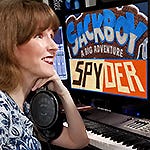
Featured Blog | This community-written post highlights the best of what the game industry has to offer. Read more like it on the Game Developer Blogs or learn how to Submit Your Own Blog Post
Anatomy of a Game Music Track: Composing Music for Skyweaver
Game composer Winifred Phillips breaks down a single piece of music from the TCG game Skyweaver, exploring in fine detail the track's structure and in-game functionality.

Delighted you’re here! I’m video game composer Winifred Phillips, and welcome to another article exploring the art and craft of game music composition! If you’re a reader of my previous articles, you’ll know that they usually include discussions of large-scale music systems and best game-wide composition strategies. Lately, it occurred to me that we might benefit from stepping away from this holistic approach, allowing us to focus on the creation of a single piece of game music. With that in mind, in this article we’ll be examining the structure and composition of a single track that I composed for the Skyweaver video game.

Skyweaver is a popular strategy trading-card video game in the tradition of such famous games as Hearthstone, Legends of Runeterra, and Magic the Gathering Arena. The game released in 2022, and currently boasts over a quarter of a million players. Investors in the Skyweaver game include both Take-Two Interactive and Ubisoft. The game is currently available for PC, Mac, Linux, Android and iOS. The track we’ll be discussing is entitled “Ready,” and it’s heard frequently during Skyweaver matches. Before we begin examining the structure of this track, let’s take a moment to discuss the nature of a strategy trading-card game.

As many of us may know, traditional real world Trading Card Games (TCGs) involve two people sitting face to face across a table, laying down cards (such as the Skyweaver cards pictured above.) In a TCG, the cards essentially ‘duel’ each other according to a set of statistics defined by the game’s ruleset. Gameplay is turn-based, and matches proceed deliberately and thoughtfully. To a casual observer, it can all seem very straightforward and slow-paced… however, a particularly great ‘turn’ can feel absolutely awesome to the expert player who comes out on top.
My involvement in the Skyweaver project began in 2019 when I met with the chief designer from Horizon Games during the Game Developers Conference. He let me know that Horizon Games was assembling a team of composers to contribute music to a new project. By the next month, I had signed on to the Skyweaver TCG project at Horizon Games and was fully underway with music composition.

The musical brief for Skyweaver posed an interesting challenge. The game is set in a science fantasy world with lots of history and lore. Featuring a light and airy visual appeal, the game is based around the idea of crystal energy sources that power the abilities of the game’s greatest warrior champions. The music for this game needed to strongly evoke the sparkling nature of the magic system. It also needed to be situated firmly in the calm and deliberate mood that characterizes a typical TCG match. Plus, it had to radiate a sense of mystic futurism (consistent with the science fantasy nature of the Skyweaver world). These were the three guiding principles for my work on this project.

In the track “Ready,” I focused first on a recurring thematic motif. It needed to be exceedingly simple, so that it wouldn’t distract players or disrupt their concentration. Nevertheless, the motif had to be recognizable when it recurred, infusing the track with a unifying melodic thread that wove everything together. Plus, the simple motif had to be carried by something that sparkled, such as a bell or a shimmering synthetic pad. Here is an example of this melody as it appeared in the “Ready” track:
This melody, along with some synth textures and ornamentation, provided sparkling identity to the track, and evoked the gemlike nature of the magic powers wielded by the Skyweavers. Next, I focused on the calm and deliberate mood that the track needed to convey. Trading card games are not exciting battles with big bursts of action and wild swings between tension and release. For the most part, a TCG match maintains a steadily moderate energy level throughout. The goal with the “Ready” track was to establish this energy level and maintain it, while introducing enough variation to keep it from feeling repetitious. I started with a simple synthetic pulse and arpeggio that rolled continuously through the musical composition and formed the rhythmic backbone of the piece. No matter how the music evolved or changed, this synthetic arpeggiation and pulsing never stopped. In the video below I’ve isolated that instrument so that you can hear what it sounded like:
To accentuate the deliberative mood and the moderate pacing of gameplay, I decided to push hard towards an infectious tempo that could inspire a subconscious “head nod” in players during a match. A deep synthetic bassline accented the downbeats while hitting enough syncopation to lend the track some satisfying forward momentum. Here’s an example of how that sounded:
Finally, the track needed to convey the mystic futurism inherent in this science fantasy setting. The Skyweaver world is populated by mythic beasts and magical creatures that wouldn’t be out of place in a fantasy RPG, but the setting also includes advanced body armor, powerful explosives, robot drones, and other high-tech wonders. With that in mind, the sonic palette for the “Ready” track focuses almost exclusively on synthetic textures and swelling pads, with contemporary and EDM percussion elements driving the track along. A heavy kick drum with tons of sub frequency reinforcement helps to give this rhythm some heft and substance. The track also features some surreal electronic elements, such as synth sounds played in reverse to lend a bit of sci-fi weirdness to the track. So let’s check out how all those elements sound:
Now that we’ve discussed the basic building blocks of the “Ready” track, let’s take a moment to think about how such a composition is structured. As a lengthy piece of music designed to support TCG matches, the “Ready” track had to complement the evolving nature of play while also acknowledging that the overall pacing and atmosphere must remain constant throughout. The music couldn’t suggest a procession to a goal, such that it might convey a slow rise of tension leading to an ultimate culmination. That composition structure would clash sharply against the consistent nature of gameplay in a TCG.
With that in mind, I structured the track around a succession of short sections, each lasting anywhere from ten to twenty three seconds. The sections naturally transitioned into each other, while providing sufficient contrast to keep things interesting. Statements of the theme would lead into modulations in major and minor mode, which would transition into bridge sections and breakdowns, which in turn would lead back into new variations of the central theme. In this video, you’ll see gameplay from Skyweaver in which the “Ready” track is featured, and I’ve included some text at the bottom of the screen to describe how the music changes from section to section:
This concludes our discussion of the “Ready” track composed for the video game Skyweaver. Taking a closer look at the creative process for a single track can provide some much-needed perspective. It’s important for us to consider a game’s design, aesthetic, and fictional world while we work. By keeping these elements in mind, we can assure that each track supports the artistic vision of the game.

Winifred Phillips is a BAFTA-nominated video game composer. The music she composed for her latest video game project Jurassic World Primal Ops won both the Global Music Award and the NYX Award, and was nominated for a Society of Composers & Lyricists Award for Outstanding Score for Interactive Media, and a Game Audio Network Guild Award in the category of Music of the Year. Other recent releases include the hit PlayStation 5 launch title Sackboy: A Big Adventure (soundtrack album now available). Popular music from Phillips’ award-winning Assassin’s Creed Liberation score was featured in the performance repertoire of the Assassin’s Creed Symphony World Tour, which made its Paris debut with an 80-piece orchestra and choir. As an accomplished video game composer, Phillips is best known for composing music for games in many of the most famous and popular franchises in gaming: the list includes Assassin’s Creed, God of War, Total War, The Sims, and Sackboy / LittleBigPlanet. Phillips’ has received numerous awards, including an Interactive Achievement Award / D.I.C.E. Award from the Academy of Interactive Arts and Sciences, six Game Audio Network Guild Awards (including Music of the Year), and three Hollywood Music in Media Awards. She is the author of the award-winning bestseller A COMPOSER’S GUIDE TO GAME MUSIC, published by the MIT Press. As one of the foremost authorities on music for interactive entertainment, Winifred Phillips has given lectures at the Library of Congress in Washington DC, the Society of Composers and Lyricists, the Game Developers Conference, the Audio Engineering Society, and many more. Phillips’ enthusiastic fans showered her with questions during a Reddit Ask-Me-Anything session that went viral, hit the Reddit front page, received 14.9 thousand upvotes, and became one of the most popular gaming AMAs ever hosted on Reddit. An interview with her has been published as a part of the Routledge text, Women’s Music for the Screen: Diverse Narratives in Sound, which collects the viewpoints of the most esteemed female composers in film, television, and games. Follow her on Twitter, Facebook, and Instagram.
Read more about:
Featured BlogsAbout the Author(s)
You May Also Like







.jpeg?width=700&auto=webp&quality=80&disable=upscale)








